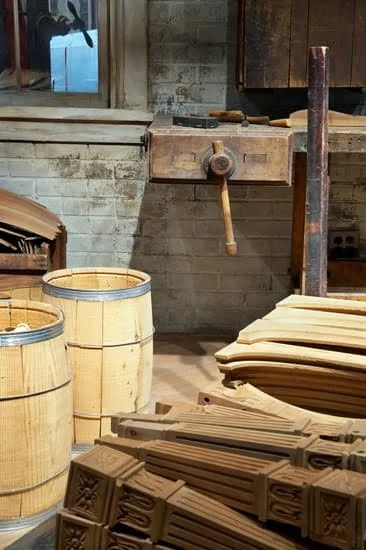Introduction to Woodwork Jobs
Woodworking is commonly thought to have originated in the Stone Age, when our ancestors began chopping and shaping wood in order to create tools and furniture. During the Bronze Age, more sophisticated wooden items were created such as chairs, chests, tables and doors. Later on during this time period saw the creation of wooden homes and even buildings.
Over time, different nations developed their own unique styles of woodwork which was based on available resources as well as what was accepted socially at the time. For instance in Ancient Egypt much of the craftsmanship featured aesthetically pleasing elements like decorative carvings and vibrant colors on wooden doors and masks. In Medieval Europe, a lot of emphasis was placed on functionality rather than design with their woodwork consisting mostly of simple sturdy structures for use both indoors and outdoors.
Woodworking began growing significantly in popularity during the Industrial Revolution when various new tools made large-scale projects easier to achieve. Items like cabinets, bookshelves and beds started being mass-produced as advances were made in machine power, design capabilities as well as accuracy levels for cuts. This allowed woodworkers to produce standardized pieces that could be quickly assembled into furniture pieces or utensils used by households all across Europe.
Today there are so many opportunities for people wanting to pursue jobs involving woodworking due to advancements in technology, availability of materials and improvement in design skills over time. Whether it’s creating fine furniture out of exotic woods or crafting toys out of balsa wood ” someone keen on exploring this field can find something that fits their style perfectly!
Popular Woodwork Jobs
Woodworking jobs are varied, with options ranging from creating intricate furniture to repairing fences. Woodworkers have been an integral part of society since early civilization and the need for their skills has only grown in the 21st century. Some of the popular types of woodworking jobs include making flooring, decks, cabinets, windows and doors, as well as furniture like chairs and desks. Woodworkers are also employed to create frames for artwork or decorative pieces such as mounted deer heads or crafted rocking horses. Highly sought-after woodworkers can even create custom heirloom pieces such as gun cabinets or antique furniture reproductions. Woodworking is often a physically demanding job that usually require strength and solid craftsmanship skills. In addition to carpentry, woodworkers must be familiar with materials and finishes associated with different types of wood in order to produce desired results.
In these modern times, advanced technologies have enabled many custom made projects that exceed traditional expectations. Computer-generated design programs now allow for mass production projects that require highly skilled and detail-oriented workers proficient in operating high tech machinery for machining complex shapes as well as finishing parts to precise specifications. Companies across industries often call on experts in this field for consulting work and project management prior to starting a new project. Lastly, several specialized roles exist in the field of conservation-focused restoration work where workers attempt to preserve unique objects such as ancient ships or houses from centuries past. As the world continues to evolve, so does the need for dependable professionals seeking out these opportunities at every level with both traditional and modernized toolsets available for executing all sizes of tasks successfully.
Skill Requirements of Woodworking
Woodworking requires a variety of different tools, techniques, and materials to craft the desired results. The types of tools used range from hand-held saws, planers and routers, to large stationary machines such as CNC routers, band saws, and table saws. Woodworking techniques also vary depending on what is being created. For example, wood carving techniques are used to create ornate furniture pieces while joints are used to form sturdy frames for tables and chairs. In addition to these basics there are many other woodworking techniques used in making cabinets or other small items including lashings, doweling, hammering and turning. Some detail work may even require the use of fine chisels or files.
The type of material used will depend on what is being made; most projects are created using softwoods such as pine or harder woods like walnut and oak. Hardwoods tend to be more expensive than softwoods due to their high demand for millwork projects such as flooring, molding or trimming a staircase banister. Depending on the type of project expected some woodworkers may wish to also work with specialty woods like balsa or rosewood as well as various types of plywood or veneers that can be bought pre-cut at lumberyards or through online stores.
In terms of safety it is essential that the appropriate clothing and gloves be worn when undertaking a woodworking project; especially those involving larger power tools which require extra caution for personal protection from potentially dangerous flying debris particles generated by the cutting action itself. Earmuffs should also be included in this kind of protective clothing regimen in order to protect hearing from loud noise levels often associated with machine tool operation typically found in any workshop environment!
Advanced Woodworking Training
Advanced woodworking training is available for experienced woodworkers who want to refine their skills, learn about new tools and techniques, and advance their career. Experiencedwoodworkers can take specialized classes in subjects like finishing techniques, cabinetmaking processes, design theory, joinery techniques, computer-aided design software, hand tools usage and more. This advanced instruction covers a wide range of projects, such as building custom furniture pieces or intricate wood carvings.
A typical advanced woodworking course can last anywhere from several weeks to several months depending on the instructor’s format and class size. In most cases, an intensive program will cover topics in depth over the span ofseveral days. However longer courses are also available that let students progress at their own pace. Regardless of length though courses usually include both practical sessions in which students practice various woodworking processes as well as lectures covering related topics such as material properties or shop safety. Students who finish these courses successfully can often receive certification depending on the instructor’s preference or requirements.
In addition to working with instructors in traditional classes there are also many online options for getting advanced instruction in woodworking principles and processes. These virtual studies generally offer a more comprehensive educational experience then individual workshops as students have access to detailed lesson plans covering a wide array of topics as well wider selection of online resources such as videos demonstrations from experts throughout the field. Online courses vary in length from week-long tutorials to month-long programs with some extending for six months and beyond for those wishing to pursue more specialist titles such as master craftsman certifications or even higher level education like art degrees in furniture making and design.
Finishing Touches
Finishing touches are an essential step in woodworking projects. They can create an overall polished look and feel and enhance the beauty of the wood. Finishes can range from simple waxes like beeswax or furniture wax, to more complex multi-step processes like lacquers and varnishes. The right finishing materials will depend on the project itself, as some finishes may only be suitable for certain types of wood or applications.
When analyzing which finish to use on a particular project, one should consider the end use of the item. Some finishes provide better protection against wear, while others offer a more decorative look with different sheen levels. There are also water-based finishes that dry quickly and don’t produce toxic fumes when applied – these are often preferred by hobbyists. It is important to also consider how much time is available for completing the project ” high-quality products often require multiple coats with drying time between each layer – but this extra effort will pay off afterwards when it comes to durability and appearance.
It’s best to experiment first on scraps of wood before using the chosen finish on the final product – this will get better results when taking into consideration how each type of finish looks and performs in different environments. Additionally, some finishes must be sealed over with other products such as paste wax or oil – taking all of these steps into account can help ensure a successful outcome for any woodworking project!
Creative Expressions in Woodwork
Woodworking projects are a great way for people to express their creativity and ingenuity. From building furniture in the home, to creating garden sculptures and outdoor furniture, woodworking offers an immense range of possibilities. It takes skill and practice to produce quality results, especially when working with complex shapes or a variety of contrasting woods. Expert artisans understand how to combine safety precautions with slick techniques in order to get the best possible results.
Advanced woodworkers may choose to specialize in certain areas of woodworking such as cabinetry or furniture making. They are also able to branch out into more intricate tasks such as marquetry or veneering ” both of which involve inlaying decorative pieces onto existing items or surfaces. This kind of work requires extreme accuracy as every piece needs to fit perfectly together, almost like a jigsaw puzzle, if it is going to look aesthetically pleasing! For those who enjoy problem solving and thinking creatively, woodwork offers an amazing playground for crafting beautiful things from natural materials
Salary Expectations
Woodwork jobs can provide a career that involves working with wood in a variety of capacities. The average salary for these positions varies greatly depending on the job title, location, and area of expertise. However, entry-level salaries tend to start at around $40,000 per year. With experience and specialized training, salaries can range from $55,000 to well over $100,000 annually.
There are a range of job titles within the field of woodworking, from skilled laborers such as Carpenters and Cabinet Makers to Architects and Designers. Those who work as cabinetmakers often specialize in manufacturing custom cabinetry or furniture for large organizations or individuals. Skilled woodworkers may also work in restoration or conservation fields where they are able to restore historic pieces or otherwise preserve them for future generations.
Other positions such as Furnituremakers may involve creating beautiful pieces by hand with an emphasis on quality craftsmanship. These craftsman must have extensive design knowledge as well as excellent hand-skills and must be ready to adapt their designs based on customer preferences. Other job roles include Shop Managers responsible for the daily operations of manufacturing facilities, Technical Instructors which focus instructing new woodworkers and Educators who teach at universities teaching courses related to Woodworking technology and history.
Woodworking Businesses
Successful woodworking businesses have a diverse selection of strategies to profit from their craft. Firstly, they rely on their reputation for providing high-quality products and services that meet their customer’s specified needs and expectations. Many successful woodworking businesses understand that by building relationships with customers in the community, they encourage repeat custom and this increases sales. In addition, they often tap into new markets through comprehensive marketing campaigns. They strive to create a strong brand identity using visuals such as logos, brochures, websites and social media content that is easy for potential customers to find and contact them by.
Furthermore, many successful woodworking businesses operate within a range of different industries which allows them to increase their customer base and spread their expertise across a variety of areas including furniture making, carpentry, cabinet making installations, architectural millwork and other specialist wood works such as sculpture or boat building. Additionally, it’s important for them to centrally organize projects in order to ensure deadlines are met while working efficiently. This allows these businesses to leverage the power of teamwork while ensuring that customers maintain an extremely high satisfaction level with their product or service. Finally, successful woodworking businesses follow safety protocols so that they can ensure workers are safe while they work. By using protective gear and always following safety guidelines not only do they protect themselves but also maintain a good public image which helps drive further business success
Conclusion
Woodwork jobs are often suited for those who have a passion for creating and designing engaging items out of wood. Careers in woodworking can be incredibly rewarding, as it allows individuals to express their creativity through projects that truly come alive once completed. Working with wood also requires technical skills and the ability to keep up with industry tools, trends, and knowledge of the craft. It is a craft that offers job security and opportunity for career growth. Despite the potential challenges faced when starting out in a new field, careers in woodworking have the potential to lead to great financial rewards and personal satisfaction. Lastly, working with wood provides an opportunity to work with your hands – something many find fulfilling and enjoyable. Whether you are just starting out or looks to switch careers, woodwork jobs offer a chance to share your creative talents and gain expertise in an ever-changing field.

Hi everyone! I’m a woodworker and blogger, and this is my woodworking blog. In my blog, I share tips and tricks for woodworkers of all skill levels, as well as project ideas that you can try yourself.





